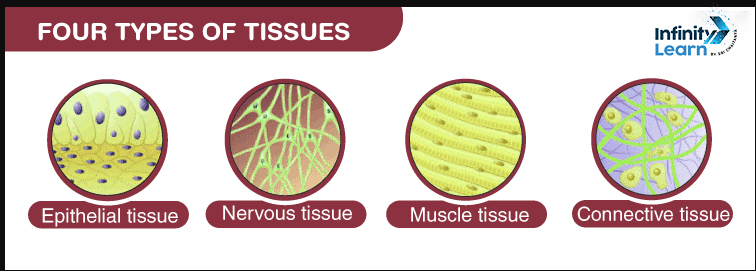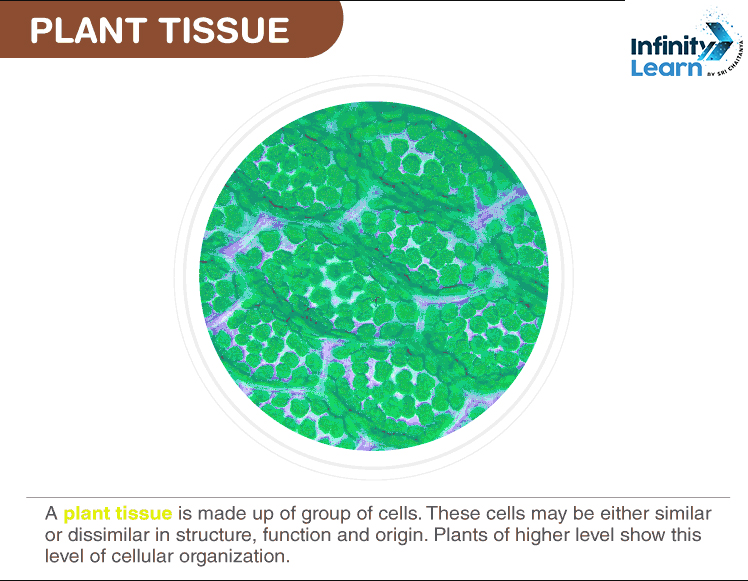Table of Contents
what is tissue?
Tissue refers to a group or collection of similar cells that work together to perform a specific function within an organism. In multicellular organisms like humans and animals, tissues are organized into various types based on their structure and function.
Let’s learn different kinds of tissues found in in different organs.
The science of studying tissues is called histology. When we examine tissues to understand diseases, it’s known as histopathology. A common method for studying tissues involves embedding and cutting them using something called a paraffin block.
Tissues and Their Types
Our body is made up of tiny building blocks called tissues. Think of tissues like teams of cells that work together to do specific jobs. There are four main types of tissues in our bodies:
- Epithelial Tissue: Imagine this tissue as a protective shield covering our organs and body surfaces, like the skin on our hands or the lining of our stomach. It keeps things in and out and helps with tasks like absorbing nutrients and secreting substances.
- Connective Tissue: Think of connective tissue as the “glue” that holds our body together. It includes tissues like bone, cartilage, fat, and even blood. These tissues provide support, cushioning, and structure to our body.
- Muscle Tissue: Picture muscle tissue as the engine of our body. There are three kinds: skeletal muscles (help us move voluntarily), smooth muscles (work automatically in things like digestion), and cardiac muscles (found in our heart and help it beat).
- Nervous Tissue: This tissue is like the body’s electrical wiring. It’s made up of cells called neurons that send signals to control everything we do, from moving our fingers to feeling emotions.
Each type of tissue plays a crucial role in keeping us healthy and functioning. Together, they make up our organs and help our body systems work smoothly.
Types of Animal Tissues
Animal tissues grouped into four categories:

- Connective Tissue
- Muscle Tissue
- Nervous Tissue
- Epithelial Tissue
These tissues team up to form organs, each with a special job. And depending on the type of animal, the cells making up these tissues can be a bit different.
Connective Tissues
Connective tissues are like the body’s support team. They’re made of cells with some space between them filled with a non-living material called the “extracellular matrix.” Think of this tissue as the glue that holds our organs together and gives them their shapes. For instance, it’s what makes our blood, bones, tendons, fat, and ligaments stay in place.
There are three main types of connective tissues:
- Fluid Connective Tissue.
- Fibrous Connective Tissue.
- Skeletal Connective Tissue.
Connective Tissue Functions
Connective tissue plays several vital roles in the body. Its main job is to give shape to organs and keep them in place. Imagine it as the body’s support system. Here are some essential things connective tissue does:
- Support and Shape: It helps organs keep their shape and stay where they belong.
- Protection: Connective tissue defends against harmful invaders, like germs, because it can eat them up.
- Insulation: It helps keep your body warm and stores extra energy.
- Connections: Connective tissue binds organs together, making sure they work well together.
- Transportation: It also helps move stuff around your body, like water, nutrients, and waste.
Muscle Tissue
Muscles are essential for making bodies move and perform various functions. There are three main types of muscle tissue:
- Skeletal Muscle: These muscles are usually connected to our bones. When we want to move our arms, legs, or other body parts, our skeletal muscles help us do that. For example, when you lift your arm, your skeletal muscles are at work.
- Cardiac Muscle: This type of muscle is special because it’s found only in one place – our heart. It’s what makes our heart beat and pump blood throughout our body. So, every time your heart beats, you can thank your cardiac muscles.
- Smooth Muscle (Visceral Muscle): These muscles are different from the others because they’re not under our control. They’re found in the walls of our organs, like our stomach and intestines. Smooth muscles help move things through our digestive system without us having to think about it.
Muscle Tissue Functions
Muscle tissues are essential for various movements in our body, such as walking, running, lifting objects, chewing, and even simple tasks like picking things up or dropping them. But that’s not all they do! Here are some other important functions of muscle tissue:
- Muscle tissue plays a crucial role in keeping us upright and maintaining our posture. So when you’re sitting or standing, you can thank your muscles for helping you stay in the right position.
- Muscles can squeeze or tighten, and they use this ability to help constrict (squeeze) our organs and blood vessels when needed. This is important for controlling the flow of blood and other substances in our body.
- Muscles are versatile; they can work when we want them to (voluntary movements, like lifting your hand) and even when we don’t consciously control them (involuntary movements, like your heart beating or digestion).
- Your heart is a special muscle that pumps blood throughout your body, ensuring oxygen and nutrients reach all your cells. Muscles also help regulate blood flow in arteries, keeping your blood pressure in check.
- Muscle tissue is responsible for the automatic movement of air in and out of our lungs, which is how we breathe. Even when we’re not thinking about it, our muscles keep us breathing steadily.
Nervous tissue
Nervous tissue in animals is a specialized type of tissue that makes up the nervous system. It is responsible for transmitting electrical signals, known as nerve impulses or action potentials, throughout the body to coordinate and control various physiological and behavioral functions.
Nervous Tissue Functions
Here are five key functions of nervous tissue in animals:
- Sensory Perception: Nervous tissue allows animals to perceive and interpret information from their environment. Specialized sensory neurons detect stimuli such as light, sound, touch, temperature, and chemicals, and transmit this information to the central nervous system (CNS) for processing.
- Motor Control: Nervous tissue is responsible for initiating and coordinating muscle movements. Motor neurons in the CNS send signals to muscles and glands to control voluntary and involuntary movements. This function enables animals to walk, run, eat, breathe, and perform various other actions.
- Cognition and Learning: Nervous tissue is essential for cognitive processes, including thinking, reasoning, problem-solving, and memory. It allows animals to learn from their experiences, adapt to changing circumstances, and make decisions based on past knowledge.
- Autonomic Regulation: The autonomic nervous system (a division of the nervous tissue) controls involuntary bodily functions, such as heart rate, digestion, and respiratory rate. It helps maintain internal balance (homeostasis) by regulating these processes without conscious control.
- Communication: Nervous tissue enables communication between different parts of the body and between individuals of the same species. Animals can convey information, such as warnings, mating signals, and social interactions, through the nervous system.
Epithelial tissue
Epithelial tissue is a type of biological tissue that lines the surfaces of various body structures and organs, both internally and externally. It serves as a protective barrier and performs several important functions.
Epithelial tissue Functions
- Epithelial tissue plays a significant role in sensory reception and contributes to various metabolic activities, including excretion and filtration.
- It provides essential mechanical strength and resilience to the cells and tissues underneath, ensuring structural integrity.
- Epithelial tissue participates in the movement of substances through processes like filtration, diffusion, and secretion.
- One of its crucial functions is safeguarding internal organs from potential threats such as pathogens, toxins, physical injuries, and radiation exposure.
Types of Plant Tissues

Plant tissues are typically categorized into three main tissue systems based on their locations within the plant:
- Epidermal Tissues: These tissues consist of cells that form the outermost layer of leaves and other plant parts. They serve as a protective barrier for the plant.
- Vascular Tissues: Vascular tissues play a crucial role in the internal transport of fluids and nutrients within the plant. They help in the distribution of water, minerals, and food throughout the plant.
- Ground Tissues: Ground tissues have multiple functions, including the production of nutrients through photosynthesis and the storage of nutrients for later use. They make up a significant portion of the plant’s internal structure.
In addition to this classification, plant tissues can also be categorized based on the types of cells they contain into two main types:
- Meristematic Tissues: Meristematic tissues consist of actively dividing cells. They are responsible for the growth and development of the plant. These tissues are typically found at the tips of roots and stems.
- Permanent Tissues: Permanent tissues are made up of cells that have completed their growth and differentiation. They serve various functions within the plant, such as support, storage, and photosynthesis.
Meristematic Tissue
Meristematic tissues are a collection of youthful cells characterized by continuous cell division, contributing to the growth in both length and width of the plant. These tissues are classified into different types based on various factors such as their location, functions, division planes, origin, and development. The three primary types of meristematic tissues, categorized by their occurrence in the plant body, are:
- Apical Meristem.
- Lateral Meristem.
- Intercalary Meristem.
Meristematic Tissue Functions
- This type of tissue takes charge of fostering the development of new organs in plants.
- It actively participates in the transportation of water and nutrients throughout the plant.
- These tissues are accountable for both the primary and secondary growth phases in plants.
- Serving as the outermost layer, its primary role is to shield the plant from mechanical injuries.
- It is instrumental in the formation of several crucial layers in plants, including the epidermis, cortex, endodermis, ground tissue, and vascular tissue.
Permanent Tissues
A group of cells that share common origins, structures, and functions is known as a group of permanent tissues. These tissues play a vital role in the ongoing growth and differentiation of cells when meristematic activity has ceased. Permanent tissues are typically classified into three main types:
- Simple Permanent Tissues.
- Complex Permanent Tissues.
- Special or Secretory Tissues.
Permanent Tissues Functions
- In aquatic plants, these types of tissues serve the purpose of enabling buoyancy, allowing the plant to float in water.
- These tissues store essential nutrients like starch, proteins, oils, and fats, serving as a reservoir of energy for the plant.
- They contribute to the firmness and hardness of fruits, such as nuts, coconuts, and almonds, providing structural support to these fruits.
- These tissues contain chloroplasts, which are vital for conducting photosynthesis, the process by which plants convert sunlight into energy.
- Permanent tissues also play a role in various other functions, including the secretion of substances, transportation of fluids and nutrients within the plant, and providing mechanical support to different parts of the plant structure.
FAQs on Tissues
What is tissue and its function?
Tissue refers to a group of similar cells that work together to perform a specific function in the body. Its primary function is to contribute to the structure and function of organs and organ systems.
What are the 4 types of tissue?
The four primary types of tissue in the human body are: Epithelial tissue, Connective tissue, Muscle tissue, Nervous tissue
What is a tissue in the body?
In the body, a tissue is a collection of specialized cells that collaborate to carry out specific functions. These tissues combine to form organs, and organs, in turn, work together to create complex systems that sustain life.
Why is it called tissue?
The term tissue is derived from the Latin word tessere, which means to weave. It is called tissue because, at a microscopic level, it appears as if cells are woven together to create a structured fabric or layer.
What is permanent tissue?
Permanent tissue is a type of plant tissue that has completed its growth and differentiation. It includes tissues like parenchyma, collenchyma, and sclerenchyma, which provide support, storage, and structural functions in plants.
Who discovered tissue?
The concept of tissues and their functions was developed over time through the work of various scientists and researchers in the field of biology and medicine. No single individual can be credited with the discovery of tissues.
What is tissue structure?
Tissue structure refers to the arrangement and organization of cells within a specific tissue type. It encompasses characteristics such as cell shape, cell arrangement, the presence of extracellular matrix, and the tissue's overall appearance under a microscope. Understanding tissue structure is essential for comprehending its function and role in the body.







